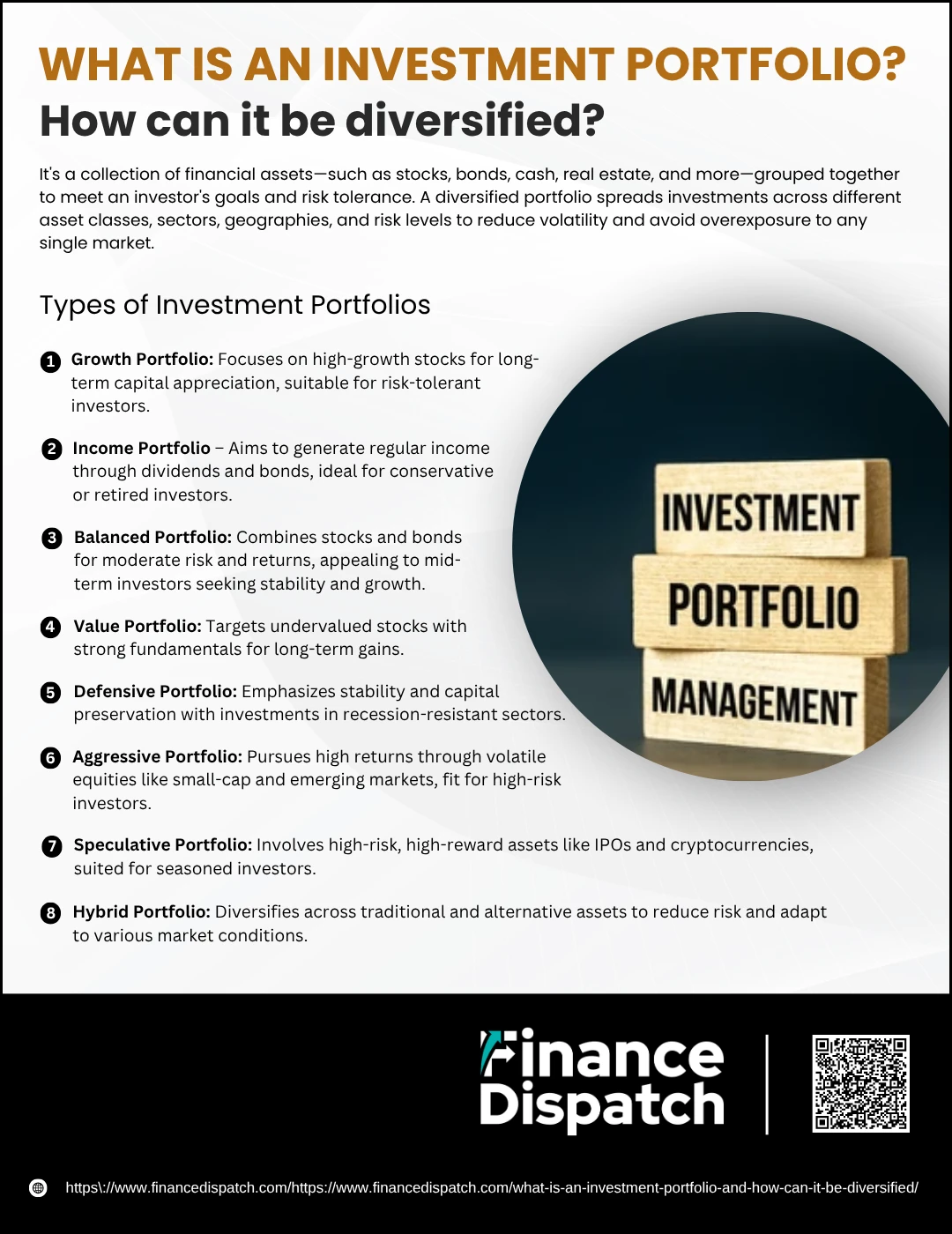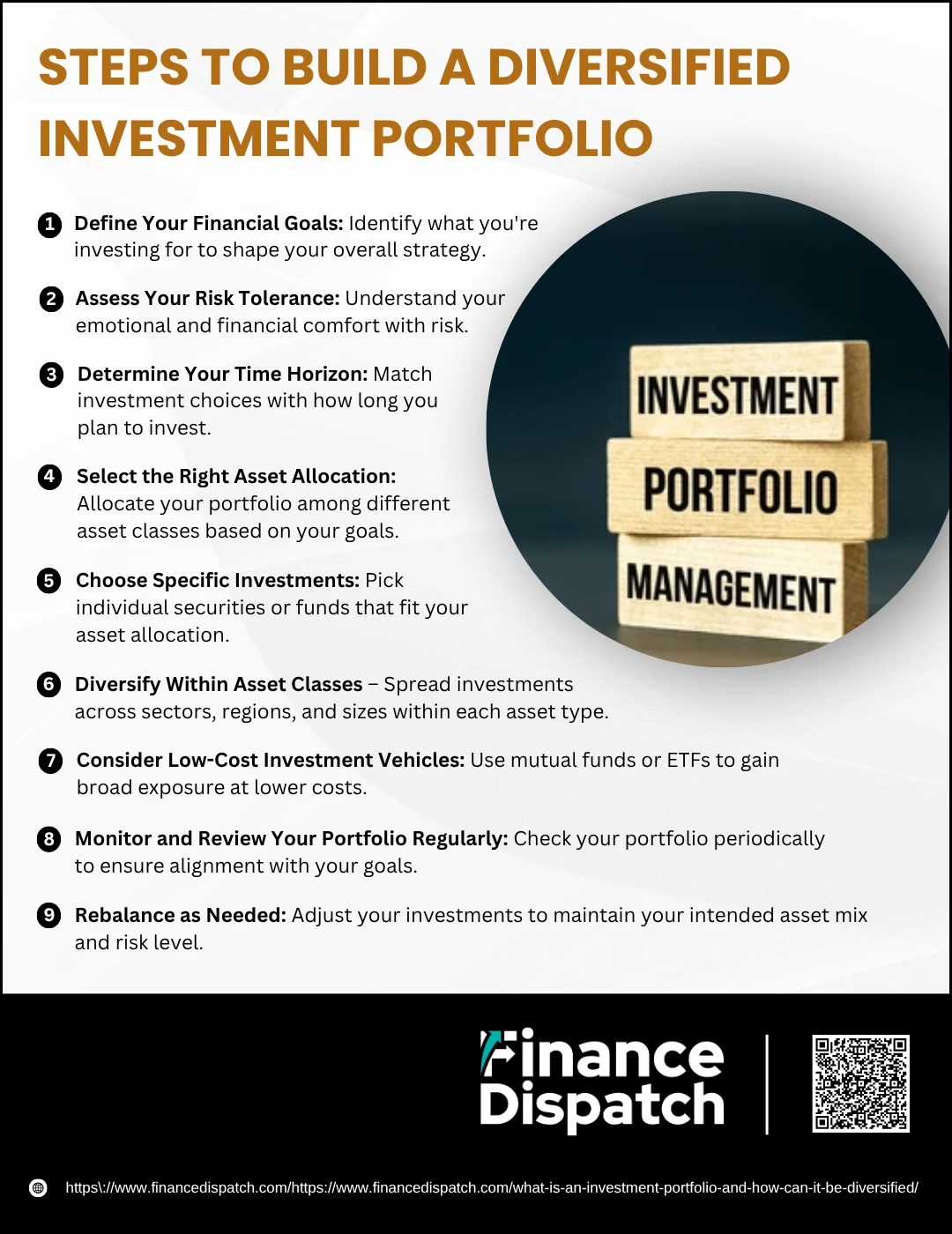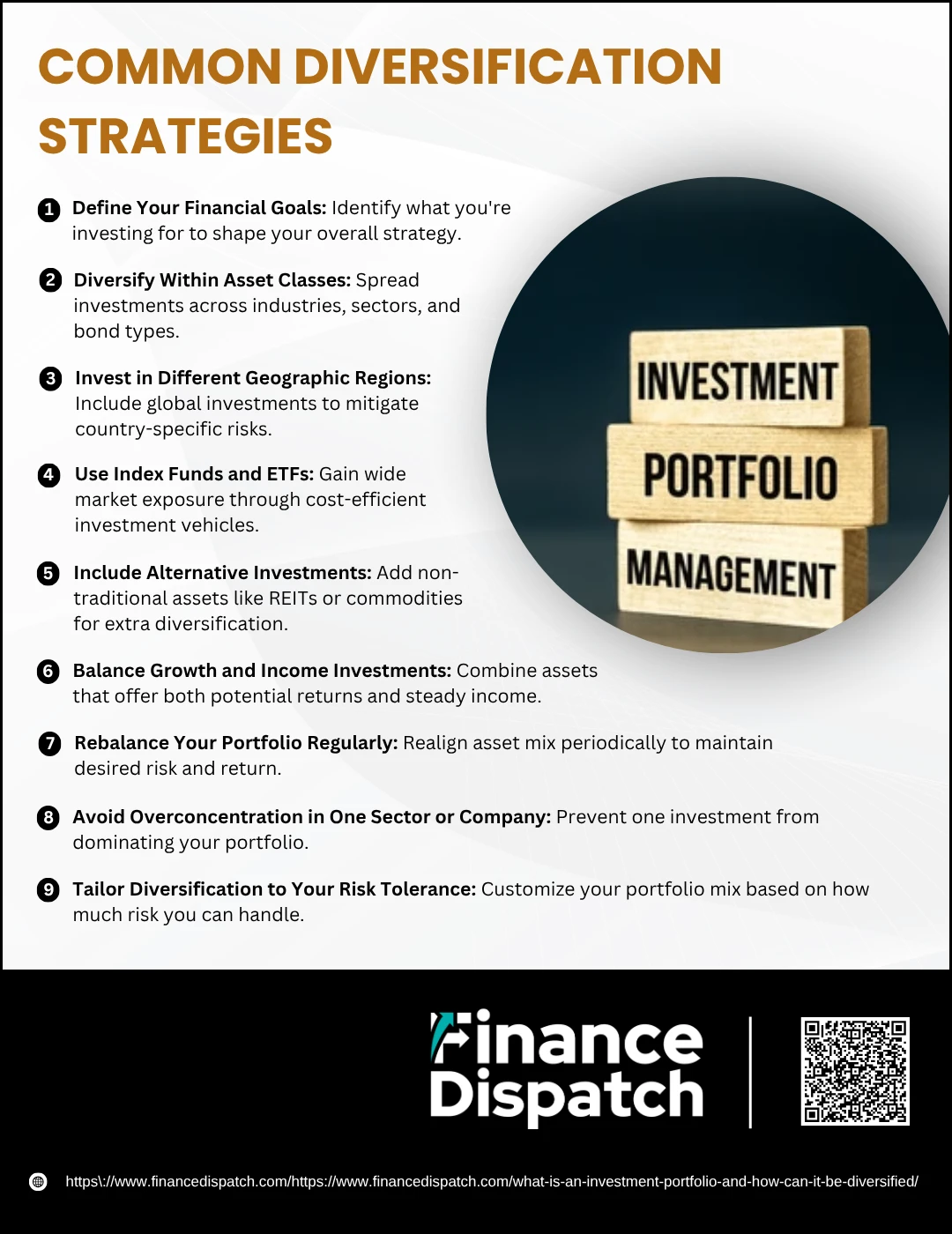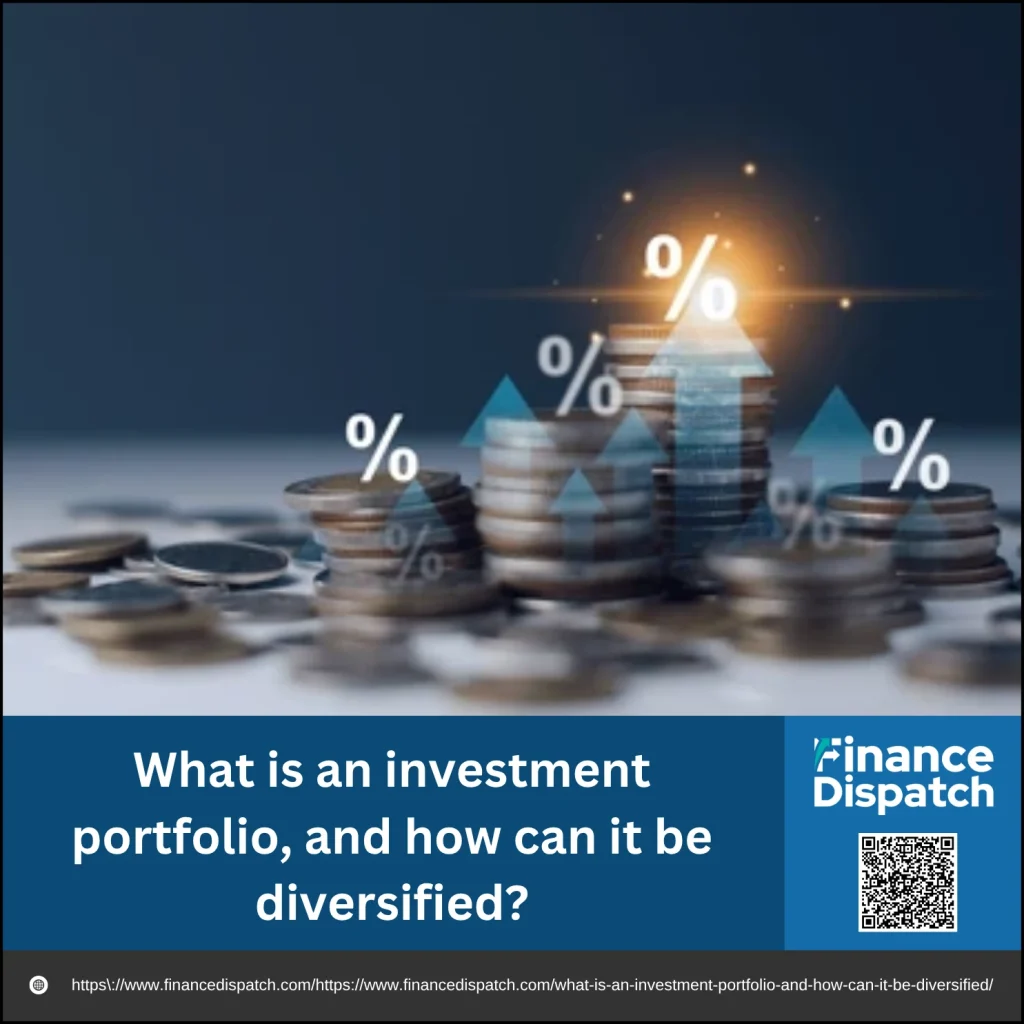An investment portfolio is more than just a collection of assets—it’s a strategic tool that reflects your financial goals, risk tolerance, and time horizon. Whether you’re saving for retirement, a home, or your child’s education, your portfolio acts as a roadmap to help grow and protect your wealth. But building an effective portfolio isn’t just about picking stocks or bonds; it’s about creating a well-balanced mix of investments that can weather market ups and downs. That’s where diversification comes in. By spreading your money across different types of assets, you can reduce risk and improve the chances of achieving long-term success. In this article, we’ll break down what an investment portfolio is, explore its core components, and show you how to diversify it wisely.
What is an Investment Portfolio?
An investment portfolio is a collection of financial assets owned by an individual or institution with the goal of generating returns over time. These assets can include stocks, bonds, cash, real estate, mutual funds, and other investment vehicles. Rather than relying on a single investment, a portfolio brings together a mix of asset types, each offering different levels of risk and return. The structure of a portfolio is tailored to the investor’s objectives, time frame, and comfort with risk—whether it’s building long-term wealth, generating income, or preserving capital. Ultimately, a well-constructed investment portfolio serves as a foundation for achieving financial goals with a strategy that balances growth and security.
 Types of Investment Portfolios
Types of Investment Portfolios
Investors come from diverse financial backgrounds and pursue different objectives—some aim for rapid growth, others prefer steady income, while many seek a balanced path. That’s why there are various types of investment portfolios, each crafted with a specific goal and risk profile in mind. Understanding these portfolio types is essential to selecting an investment strategy that matches your financial goals, whether you’re saving for retirement, building wealth, or preserving capital.
1. Growth Portfolio
A growth portfolio is built to maximize capital appreciation. It typically consists of high-growth stocks, often from emerging industries or younger companies. These investments carry more volatility but also the potential for higher long-term returns. This type of portfolio is ideal for investors with a long time horizon who are comfortable with market fluctuations and short-term losses in exchange for future gains.
2. Income Portfolio
Designed to generate consistent income, this portfolio focuses on dividend-paying stocks, government or corporate bonds, and real estate investment trusts (REITs). It’s well-suited for retirees or conservative investors who prioritize steady cash flow over aggressive growth. While it may not offer high capital gains, it provides regular payouts and a relatively stable investment experience.
3. Balanced Portfolio
A balanced portfolio blends growth and income objectives by investing in both equities and fixed-income securities. This approach aims to reduce risk through diversification while still offering the potential for moderate returns. It appeals to investors with medium risk tolerance and a mid- to long-term investment outlook who want both stability and growth.
4. Value Portfolio
This portfolio type focuses on undervalued stocks that are trading below their perceived intrinsic value. Investors in value portfolios look for companies with strong fundamentals that may be temporarily overlooked by the market. The goal is to achieve gains when the market eventually recognizes their true worth. It’s a strategy often used by patient, long-term investors who prefer a more conservative approach to equity investing.
5. Defensive Portfolio
A defensive portfolio prioritizes capital preservation and stability, especially during market downturns. It includes investments in sectors like utilities, consumer staples, and healthcare—areas that tend to perform steadily regardless of economic conditions. This approach is favored by risk-averse investors who prefer predictable returns and lower exposure to volatility.
6. Aggressive Portfolio
Focused on maximizing returns, an aggressive portfolio includes a high percentage of equities, particularly in small-cap and emerging market stocks. It involves significant short-term risk but can deliver substantial long-term rewards. This portfolio is suited for young investors or those with a long investment horizon and a strong appetite for risk.
7. Speculative Portfolio
A speculative portfolio includes high-risk investments such as IPOs, cryptocurrencies, penny stocks, and start-ups. These assets are chosen for their potential to deliver extraordinary returns, though they come with a high chance of loss. This portfolio is best for experienced investors who understand the market and are willing to accept substantial risk for the possibility of exceptional gains.
8. Hybrid Portfolio
A hybrid portfolio diversifies across traditional and alternative asset classes, including stocks, bonds, real estate, commodities, and sometimes even collectibles or hedge funds. This approach aims to reduce overall portfolio risk by balancing uncorrelated assets. It’s ideal for investors seeking a well-rounded strategy that can perform in different economic environments.
Key Components of an Investment Portfolio
An investment portfolio is most effective when it includes a mix of different asset types, known as asset classes. Each component plays a unique role—some focus on growth, others offer stability or income. The right combination depends on your financial goals, risk tolerance, and time horizon. A well-diversified portfolio includes multiple asset classes to balance potential returns and risks across different market conditions.
1. Stocks
Represent ownership in companies and offer the potential for high returns through capital appreciation and dividends. They are generally more volatile but can drive long-term growth.
2. Bonds
Debt securities issued by governments or corporations that provide regular interest payments. Bonds are typically less risky than stocks and offer income and stability.
3. Cash and Cash Equivalents
Highly liquid, low-risk investments such as savings accounts, money market funds, or certificates of deposit (CDs). These assets are useful for emergency funds and short-term goals.
4. Real Estate
Includes direct property ownership or indirect investment through real estate investment trusts (REITs). Real estate can provide rental income and capital appreciation but is less liquid than other assets.
5. Commodities
Physical goods like gold, oil, or agricultural products. Commodities can hedge against inflation and add diversification to a portfolio.
6. Mutual Funds and ETFs
Pooled investment vehicles that hold a diversified basket of assets. These funds offer built-in diversification and professional management, making them ideal for beginner and passive investors.
7. Alternative Investments
Non-traditional assets such as private equity, hedge funds, art, or cryptocurrencies. These can offer high potential returns and diversification, but often come with higher risk and limited liquidity.
What is Diversification and Why Does it Matter?
Diversification is a foundational principle in investing that involves spreading your money across different types of assets to reduce overall risk. Instead of relying on a single investment or asset class, a diversified portfolio includes a mix—such as stocks, bonds, real estate, and commodities—that react differently to market conditions. This strategy helps protect your portfolio from significant losses if one investment underperforms, as gains in other areas can offset the decline. Diversification matters because it smooths out the ups and downs of investing, increases the potential for steady returns, and gives you a better chance of reaching your financial goals with less stress during market volatility.
 Steps to Build a Diversified Investment Portfolio
Steps to Build a Diversified Investment Portfolio
Building a diversified investment portfolio isn’t just about picking a few different stocks or bonds—it’s a strategic process that takes into account your financial goals, tolerance for risk, and the time you have to invest. A well-diversified portfolio can protect you from sharp market declines and help you grow your wealth steadily over time. Follow these key steps to create a portfolio that’s tailored to your unique financial situation.
1. Define Your Financial Goals
Begin by clearly identifying what you’re investing for. Are you saving for retirement, a child’s education, a future home, or general wealth building? Knowing your goals helps shape your investment decisions, including how much risk you’re willing to take and what types of returns you’ll need to achieve them.
2. Assess Your Risk Tolerance
Risk tolerance is both emotional and financial. Ask yourself how comfortable you are with potential losses and how much fluctuation you can handle without panicking. Also consider your financial ability to recover from a downturn. Being honest about your risk appetite will help you avoid emotional decisions and stick to your plan.
3. Determine Your Time Horizon
The length of time you plan to keep your money invested has a big impact on your strategy. A longer time horizon—like 20 or 30 years—means you can take on more risk and invest in assets with higher growth potential. A shorter time horizon calls for safer, more stable investments to preserve capital.
4. Select the Right Asset Allocation
Asset allocation is the blueprint of your portfolio. It refers to how you divide your investments among major asset classes like equities (stocks), fixed income (bonds), cash, real estate, or commodities. A younger investor may choose a more aggressive allocation (e.g., 80% stocks), while someone nearing retirement may lean toward safety (e.g., 60% bonds).
5. Choose Specific Investments
Once your asset allocation is set, choose investments that align with each category. For example, you might select index funds or ETFs for stock exposure, and municipal or corporate bonds for income. Make sure your selections fit your goals, risk level, and budget.
6. Diversify Within Asset Classes
True diversification goes beyond just having different asset types—it involves spreading your money within each category. For example, in stocks, invest across different sectors (technology, healthcare, consumer goods), market caps (small-cap, mid-cap, large-cap), and regions (domestic and international).
7. Consider Low-Cost Investment Vehicles
Diversification doesn’t have to be expensive. Mutual funds and ETFs provide exposure to hundreds of assets in a single investment. They’re ideal for beginners and help lower your overall costs, especially when you choose funds with low management fees.
8. Monitor and Review Your Portfolio Regularly
Your financial goals, risk tolerance, and market conditions can change over time. It’s important to review your portfolio at least once or twice a year to ensure it still aligns with your objectives. Look for any major deviations in performance or allocation that might require attention.
9. Rebalance as Needed
Over time, certain assets in your portfolio may grow faster than others, causing your allocation to shift. Rebalancing means adjusting your holdings—by selling overperforming assets and buying underperforming ones—to restore your original allocation. This maintains your desired level of risk and keeps your strategy on track.
 Common Diversification Strategies
Common Diversification Strategies
Diversification is not just about owning different investments—it’s about selecting a strategic mix that helps reduce overall risk while maintaining potential for returns. A well-diversified portfolio spreads investments across various asset types, sectors, and geographic regions to avoid overexposure to any single source of market volatility. Here are some of the most effective strategies you can use to diversify your investment portfolio:
1. Diversify Across Asset Classes
One of the most basic and important strategies is to invest in a variety of asset classes—such as stocks, bonds, cash, real estate, and commodities. Each asset class reacts differently to market changes, so holding a mix can help smooth returns over time.
2. Diversify Within Asset Classes
Don’t just buy one stock or bond—spread your investments within each category. For example, in stocks, invest in different sectors like technology, healthcare, and energy. In bonds, consider various issuers and maturities to reduce risk.
3. Invest in Different Geographic Regions
Geographic diversification protects you from country-specific risks. By investing in both domestic and international markets, you can benefit from global growth opportunities while reducing dependence on a single economy.
4. Use Index Funds and ETFs
These investment vehicles provide instant diversification by pooling together a large number of assets. A single index fund or ETF can give you exposure to hundreds or even thousands of companies, sectors, or regions at once.
5. Include Alternative Investments
Consider adding alternative assets such as real estate investment trusts (REITs), commodities like gold or oil, or even hedge funds and private equity. These often move independently from traditional markets, adding another layer of risk management.
6. Balance Growth and Income Investments
Blend high-growth investments like equities with income-generating assets such as dividend-paying stocks or bonds. This combination helps you pursue capital appreciation while maintaining a steady income stream.
7. Rebalance Your Portfolio Regularly
Even a diversified portfolio can drift over time due to changes in market value. Periodically review and rebalance your portfolio to maintain your desired allocation and risk level.
8. Avoid Overconcentration in One Sector or Company
Ensure that no single investment makes up a disproportionate share of your portfolio. Overexposure to a trending industry or a favorite company increases risk if that area underperforms.
9. Tailor Diversification to Your Risk Tolerance
Not every investor needs the same level of diversification. If you’re risk-averse, you may favor more conservative assets and greater diversification. If you’re aggressive, you might accept more volatility but should still spread risk wisely across multiple investments.
Asset Allocation Funds vs. Customized Models
When building a diversified portfolio, investors often choose between two approaches: asset allocation funds and customized asset allocation models. Both aim to manage risk and achieve long-term goals through a mix of investments, but they differ in control, flexibility, and personalization. Asset allocation funds offer a one-size-fits-all solution with automatic management, while customized models allow you to fine-tune your investment strategy based on your unique financial goals, risk tolerance, and time horizon. The choice depends on how involved you want to be in managing your portfolio and how much flexibility you require.
| Feature | Asset Allocation Funds | Customized Asset Allocation Models |
| Definition | Pre-packaged funds that invest in a diversified mix of assets | Individually tailored mix of assets based on personal criteria |
| Control | Limited—managed by fund managers | High—investor selects allocation and investments |
| Flexibility | Fixed strategy, often based on target dates or risk levels | Fully flexible to adjust as goals or markets change |
| Management Style | Passive or active management by professionals | Self-directed or guided by a financial advisor |
| Best For | Hands-off investors seeking simplicity | Hands-on investors who want personalized strategy |
| Examples | Target-date funds, balanced funds, growth/income funds | Custom 60/40 stock-bond split, sector-specific allocations |
| Rebalancing | Automatically rebalanced by the fund | Must be monitored and rebalanced manually or by advisor |
| Costs/Fees | Typically includes fund management fees | May be lower if using low-cost ETFs or index funds |
Conclusion
A well-structured investment portfolio is essential for achieving your financial goals while managing risk effectively. By understanding what an investment portfolio is, recognizing its key components, and applying diversification strategies, you can build a portfolio that stands strong through market ups and downs. Whether you prefer the simplicity of asset allocation funds or the flexibility of a customized model, the goal remains the same: to create a balanced, resilient investment plan tailored to your needs. Regularly reviewing and adjusting your portfolio ensures it stays aligned with your evolving objectives, helping you stay on track toward long-term financial success.



